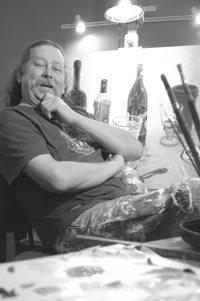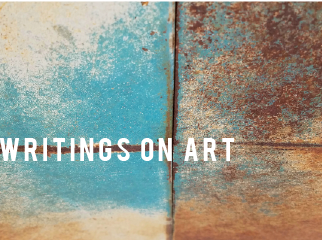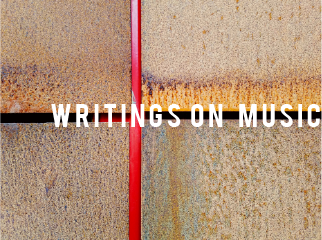Mike Flinn
“Holding the Keys: Mike Flinn”
By Katy Dang
Boise Weekly | July 26, 2006
https://www.boiseweekly.com/boise/holding-the-keys/Content?oid=928876
Mike Flinn’s world is made up of many components. There is the editorial cartoonist (he’s penned his “Mondo Gaga” cartoon for Boise Weekly since 2004), the commercial artist, the collaborator and the fine art painter. At times, he switches out one component for another; at other times, he is firing on all cylinders at once. It’s a world that is well worth entering for those with a sense of humor, an eye for the absurd, and a taste for the austere.

Born in Long Beach, California, Flinn moved with his family to Idaho as a teenager in 1968. He had already been influenced by the SoCal surfer art that would serve as early inspiration to the blossoming artist. The graffiti lines had left their mark, as had the work of Rick Griffin, especially his cartoon in Surfer Magazine, “Murph the Surf.”
“He’s the man,” says Flinn, who still has a photograph of Griffin hanging in his studio. With Griffin as his inspiration, Flinn started drawing early on. Later, he took his first art class at Meridian High School and was hooked.
“I started seeing all of the psychedelic stuff coming out of San Francisco,” Flinn recalls. “Then I started looking into it, and found out that guys had been doing this wiggly-squiggly stuff for centuries. I went crazy, and had to know everything about all the people that I didn’t know anything about.
“I took my first paycheck from my first job and bought a Dali coffee table book,” says Flinn. He still has that book, as well-thumbed as it is. He started researching the other artists he liked and picked up a copy of Surrealism by Herbert Read.
“Early on, I wanted to paint like them; Max Ernst and all those guys,” he says. Since then, he has developed his own unique style that draws on his early influences while avoiding being pigeonholed in a specific school of painting. He recalls noticing years later the wild turn that computer graphics had taken.
“I said, ‘That’s it; it’s over for artists. Computer graphics have taken surrealism away from the artist,” he says.
In his work now, he is moving towards a surrealist-expressionist take, in which the point of view of the artist is injected into the painting. “You have to be able to get what you think into the painting, and do something the CGI guys can’t do,” he says. “They all do the same thing with the same program, so it’s important to do something they can’t.”
Flinn has run a successful graphic design business in Boise for many years. “I have my bread-and butter-clients,” he says. “I’m able to make my living as an artist, and that’s important.” Still, it can be difficult to fit everything in. “When you do art for a living, it’s kind of like being a mechanic and then going home and working on your own car,” he says.
In addition to his commercial work and his painting, Flinn is an accomplished cartoonist, having had work published in Rod Serling’s Twilight Zone Magazine in the ’80s and contributing work to the inimitable 1999 comic book, Shut Up, Little Man!, featuring the eminently illustratable characters of Peter and Raymond. “Mondo Gaga” features the insights of Ival the Eyeball, who always gets to have the last word, and may well be a nod to Rick Griffin’s flying eyeballs in his work during his psychedelic rock poster phase. “Ival is sort of my alter ego,” says Flinn. He penned the “IdahOblivion” cartoon in 2001-2002 for BW, but decided to take some time off. “I quit cartooning for a while,” he says. “After a while, though, I noticed that I missed the outlet that cartooning provides; I realized I had started yelling at the cats.” Flinn’s editorial cartoons take on any subject and he isn’t afraid to grab topics by the horns. “Everybody’s got an opinion,” he says proudly, “but I get paid for mine.”
Flinn started painting again seriously after 9/11, and approached the Basement Gallery’s Perry Allen about showing some of his work.
“The response to his first show was killer: it was just a knockout,” remembers Allen. “People knew him from his cartoons and didn’t realize how serious he was as an artist.” Allen has bought several of Flinn’s pieces himself, and has featured him in three shows, with a fourth coming up in September. The show will also feature Tarmo Watia, Sue Rooke and Kirsten Furlong. In addition to showing new work, Flinn will sell some of his original 11-by-11-inch cartoons. He will also unveil the fruit of his latest collaboration with guitar-maker extraordinaire John Bolin. This will be the third time the two have worked together on a gallery piece, with Flinn providing the artwork for one of Bolin’s custom guitars.
“We’ve worked together for 20 years,” says Bolin. “In this business, I try to surround myself with artists. It’s healthy to swim in the same pond.” The two have collaborated on guitars that are now owned by some of the biggest names in rock-and-roll. “Mike and I are a two-headed monster: When we put our heads together, we do some really great work.”
“He’s extremely professional and unbelievably talented,” says Bolin. “Put it this way; he’s the best I’ve ever worked with.”
“Mike does really wild stuff,” says Allen. “What I like the most about him is that he doesn’t hold back: He puts it all out on the canvas. He’s also incredibly versatile. His work ranges from being very serious to really funny and whimsical, even while making some pretty serious statements. One painting of his cracked me up so much that I laughed for 10 minutes. Then I bought it,” says Allen.
Flinn will be at the opening for his show in September, a task which he says is just “part of the gig of being an artist.” Like many artists, he finds it difficult to talk about his work in a structured setting. “It takes all the fun out of it if I explain it,” he says. “I’ve had people come up to me and say, ‘You don’t know what this stuff means,’ which is kind of true. And I’d rather have the best critic in Idaho pan me that have another friend tell me I’m great.”
Flinn has a good parable for what it’s like to talk about his work, and like any good Irishman, has a real knack for telling a tale: “I know a guy who carried a keyring of maybe a hundred different keys. It never failed, upon seeing that huge ring, that some drunken bar denizen would ask, ‘Hey, I bet you don’t have any idea what all those keys are for, do you?’ Because this fellow knew his business, he would, one by one and in great detail, describe what each key was for: each building, bathroom, garage, truck, office, elevator, basement, etc. By the time this guy was on key 25 or so, the deflated challenger would be begging him to quit. At which point that particular conversation would come to an end, and this fellow would smile the smile of the knowing.
“This is what it’s like to explain a painting to someone: ‘Hey, I bet you don’t have any idea what that shit means, do you?’ Well, yeah; actually, I do. There’s lots o’ keys, though.”



